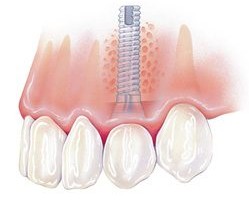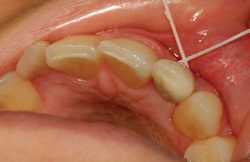What to Consider when Getting a Dental Implant
Have you been considering a dental implant? If so, it is important to know what a dental implant is, what the benefits and risks of a dental implant are and what is required to maintain your dental implant following placement.
What is a dental implant?
A dental implant is the closest substitute you can have for healthy, natural teeth. Implants are usually the best option for missing teeth. An implant is placed into the jawbone and acts as a substitute root. It fuses with the natural bone and becomes a very strong foundation. After a couple months of healing, a connector (abutment) is used to secure the implant to a substitute tooth (crown).
What are the benefits of dental implants?
Dental implants are strong and function like natural teeth. They can last a lifetime if they are properly cared for. No need to worry about them slipping or moving out of place because, unlike dentures, they are permanently attached to your jawbone. When a tooth goes missing, the jawbone starts to deteriorate because it is not being used. Since an implant is the only dental option that stimulates natural jawbone, loss of bone strength and density can be avoided. Finally, you can eat anything with your implant that you could with your own teeth! It is not susceptible to cavities.
What are the risks of dental implants?
Like any other surgery, there are some risks to dental implant placement. Problems are very rare and are usually minor and easily treated. It is possible for the implant site to become infected. Surrounding teeth and other structures can be damaged during placement. Nerve damage is a risk that can cause pain, numbing or tingling in your other teeth, gums, chin, etc. Sometimes during placement of an implant in your upper jaw, the implant can puncture your sinus membrane. This can lead to infection and implant failure.
What is required to maintain your dental implant following placement?
Flossing is crucial following dental implant placement. An implant is susceptible to inflammation and peri-implant disease if not properly cared for. The reason for this is that bacteria can get lodged between your gum tissue and the crown of the implant. There are many types of floss on the market, and it’s a good idea to use unwaxed tape or implant-specific floss in order to protect the tissue surrounding the implant. To floss an implant, insert the floss on both sides of the implant. Wrap in a circle and crisscross in front. Then, use a shoe-shine motion to work your way in between the tissue and implant crown (as shown in picture below).
http://www.aaid-implant.org/about-dental-implants
http://www.rdhmag.com/articles/print/volume-33/issue-9/features/focus-on-implant-home-care.html
http://www.mayoclinic.org/tests-procedures/dental-implant-surgery/details/risks/cmc-20245747
https://www.ncbi.nlm.nih.gov/pubmed/21278522


